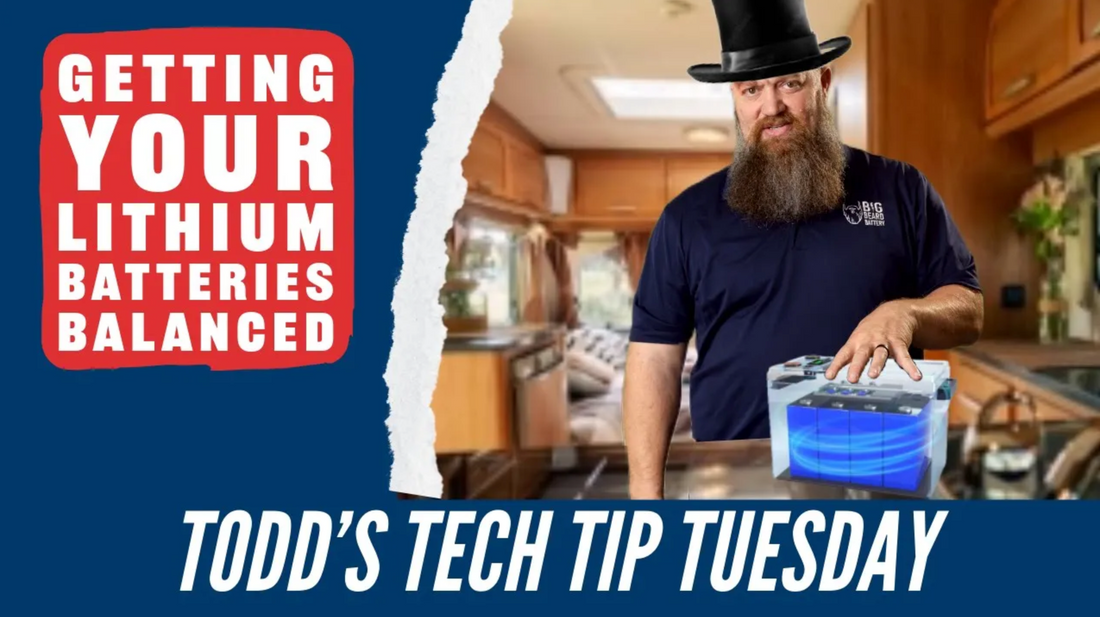Welcome back to another Tech Tip Tuesday! Today, we’re diving into a great question from one of our loyal viewers, Stu, who’s looking for advice on managing a large battery bank relative to his solar panel setup.
The Scenario
Stu has a sizable battery bank—600 amp hours of lithium batteries, to be exact—paired with 800 watts of solar panels. His concern? The mismatch between his battery capacity and solar input, and whether not fully charging his lithium batteries regularly could have long-term consequences.
Understanding the Battery Bank and Solar Panel Mismatch
Stu’s setup is impressive: 600 amp hours of lithium batteries and 800 watts of solar panels. For context, each of these batteries at 12 volts packs 1,200 watts, giving a total of about 9,000 watts. However, with only 800 watts of solar input, there’s a clear imbalance between his battery storage and the energy being replenished. To put it simply, Stu’s demand slightly exceeds his panel's output.
Stu reports running his gas generator or plugging in to top off his batteries every four to six days. The fact that he can stretch it that long is pretty remarkable! However, his main question is whether not fully charging his lithium system regularly could shorten the battery life or reduce the overall output.
The Importance of Fully Charging Lithium Batteries
The short answer is yes—if you don’t fully charge your lithium batteries regularly, you could be risking a shorter lifespan and reduced efficiency. But let’s break down why this happens.
Inside a typical lithium iron phosphate battery, there are multiple cells—let’s say four for simplicity. These cells need to be balanced, and the best way to achieve that balance is by charging them up to 100%. When the batteries are fully charged, your system may enter what’s called “float mode,” where the batteries are topped off. Occasionally, it’s necessary to enter “absorption mode,” where the batteries receive a higher voltage charge (around 14.5 to 14.6 volts) to balance the cells.
If the cells aren’t balanced regularly, one cell might become weaker than the others, and over time, the variance between the cells can grow. This imbalance can lead to one cell dictating the battery's overall performance, cutting off power prematurely and reducing the battery’s efficiency.
How to Properly Balance Your Batteries
For those with a setup like Stu’s, it’s recommended to enter absorption mode at least once every seven days for about three hours. For Stu’s 600 amp hours, that means staying in absorption mode for at least three hours every week, whether through your solar controller or inverter charger. This practice ensures the cells remain balanced and prolongs the life of your batteries.
What Happens if You Don’t Balance?
While skipping regular balancing won’t instantly destroy your batteries, it will gradually shorten their lifespan. For instance, if your batteries come with a 10-year warranty but are never balanced properly, you might only get six or seven years out of them. Additionally, if the battery manufacturer checks your Battery Management System (BMS) and sees that your batteries were never balanced to the required voltage, they might not honor the warranty.
A Special Note for Big Beard Battery Users
If you’re using Big Beard batteries, there’s some good news. These batteries feature internal active balancing at lower voltages, meaning they’re less prone to the issues mentioned above. But for everyone else, it’s essential to follow the recommended charging practices to ensure longevity and efficiency.
Final Thoughts
Stu, thanks for your thoughtful questions and for being a regular contributor to our Tech Tip Tuesday! Your situation highlights the importance of understanding your battery system and taking proactive steps to maintain it. By following these tips, you can maximize the lifespan of your lithium batteries and keep your system running smoothly.
Until next time, happy RVing, and keep those questions coming!

